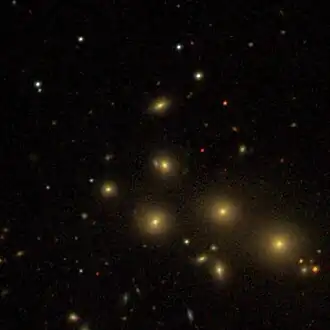NGC 3647
| NGC 3647 | |
|---|---|
 | |
| Observation data | |
| Constellation | Leo |
| Right ascension | 11h 21m 32.6s[1] |
| Declination | +02° 53′ 14″[1] |
| Redshift | 0.04985 0.00001 |
| Heliocentric radial velocity | 14,573 km/s |
| Distance | 747 Mly |
| Apparent magnitude (V) | 15.6 |
| Characteristics | |
| Type | E |
| Size | 72,000 ly |
| Other designations | |
| PGC 34816, 2MASX J11213813+0254119, Z 39-142, SDSS J112138+025411.4 | |
NGC 3647 is a small elliptical galaxy in the Leo constellation.[2] The galaxy was first discovered on March 22, 1865 by Albert Marth who was a German astronomer.[1] It is approximately 747 million light-years away.[3] Due to its close proximity to five other elliptical galaxies, there was a bit of confusion for Marth to identify which object is NGC 3647.[1]
According to SIMBAD, it is identified as PGC 34816.[4] But in HyperLeda and by NASA/IPAC databases, NGC 3647 is identified as PGC 34815.[3] The correct designation for this article, according sources from wikidata is PGC 34816. There is no evidence whether this galaxy has an active nucleus or not.
References
- ^ a b c d "New General Catalog Objects: NGC 3600 - 3649". cseligman.com. Retrieved 2024-04-16.
- ^ "NGC 3647 - Elliptical Galaxy in Leo | TheSkyLive.com". theskylive.com. Retrieved 2024-04-16.
- ^ a b "Your NED Search Results". ned.ipac.caltech.edu. Retrieved 2024-04-16.
- ^ "NGC 3647". simbad.u-strasbg.fr. Retrieved 2024-04-16.